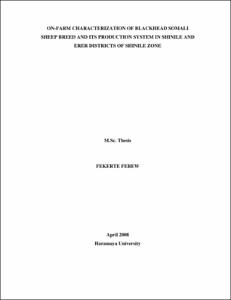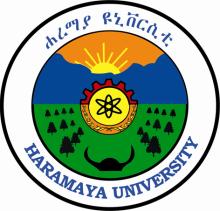Resource information
The study was carried out in Shinile and Erer districts of Shinile Zone of the Somali National Regional State. The objectives of the study were: to characterize the production system and phenotypic characteristics of the Blackhead Somali; to evaluate on-farm survivability/ mortality of Blackhead Somali lambs during pre- weaning period and to determine the best fitted regression model for prediction of live weight of Blackhead Somali sheep breed based on body measurements under field conditions. Data were gathered through semi-structured questionnaire, focus group discussions, field observations and linear body measurements of sample populations. The overall least square mean reported Blackhead Somali sheep was 19.19. Generally, decreasing trends in Blackhead Somali sheep breed was reported. The major feed resource was natural pasture and source of water were from rivers, wells, natural ponds. Corral was used to house the sheep and goats together and they practiced partial controlled mating system. The reported production constraints were disease, feed and water shortage. According to farmers’ report, the overall average age at puberty in females was 17.97 ± 3.97 and 13.65 ± 4.75 months in males. Age at first lambing, lambing interval , reproductive life span, and life time lamb production were 23.56 ± 3.63 months, 10.46 ± 2.58 months, 9.12 ± 1.6 years and 8.18 ± 2.27 lambs, respectively. Per-weaning mortality rate was 47.8% and the major cause was disease (59.1%). The coat color patterns of Blackhead Somali sheep breed varies from patchy, pied and plain. The dominant color was black color of the head with white body color; body covered with short smooth hair, fat rumped tail and straight head profile; wattle was absent in female but present in male. The sheep flocks observed constituted higher proportions of females than males. Sex of animals had significant effect on body weight and linear body measurements except tail length, ear width and cannon bone circumference. Males were heavier than females (29.50 kg vs. 25.80 kg) and had higher heart girth (72.72 cm vs. 71.29 cm), height at withers (61.30 cm vs. 59.97cm), and body length (65.82cm vs. 63.94 cm). The district effect was significant (p<0.05) for some measurements. Dentition classes of animals contributed significant differences to the body weight and some of linear body measurements. Body weight was highly correlated (P < 0.01) with body dimensional traits with moderate to high positive correlation both in males (r=0.62- 0.81) and females (r=0.63- 0.83). Based on fitted regressions models, heart girth was found to predict body weight with higher precision; height at wither with body length in combination with heart girth explained up to 75 % variation in body weight in both sexes. Best Fitted Regression equation based on R2 Value are Y= 34.95 +0.15BL +0.52HG +0.19HW +0.06TC (R2=76%) for females and Y=- 29.4+0.2BL +0.4HG+0.17HW+ 0.11TC (R2=77%) for male. Generally this breed showed their ability to thrive well and their potential for meat production under the prevailing harsh environmental conditions.



